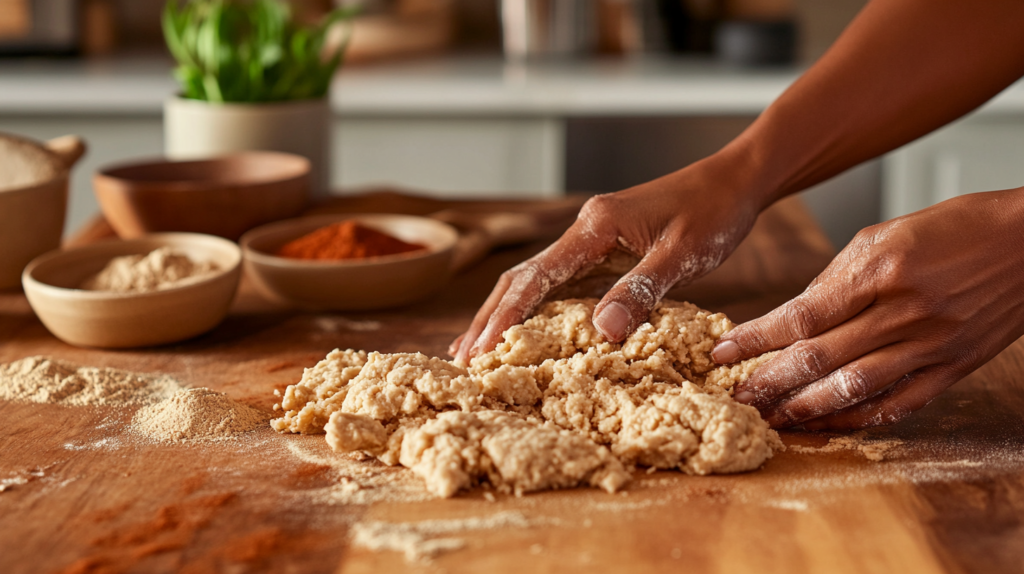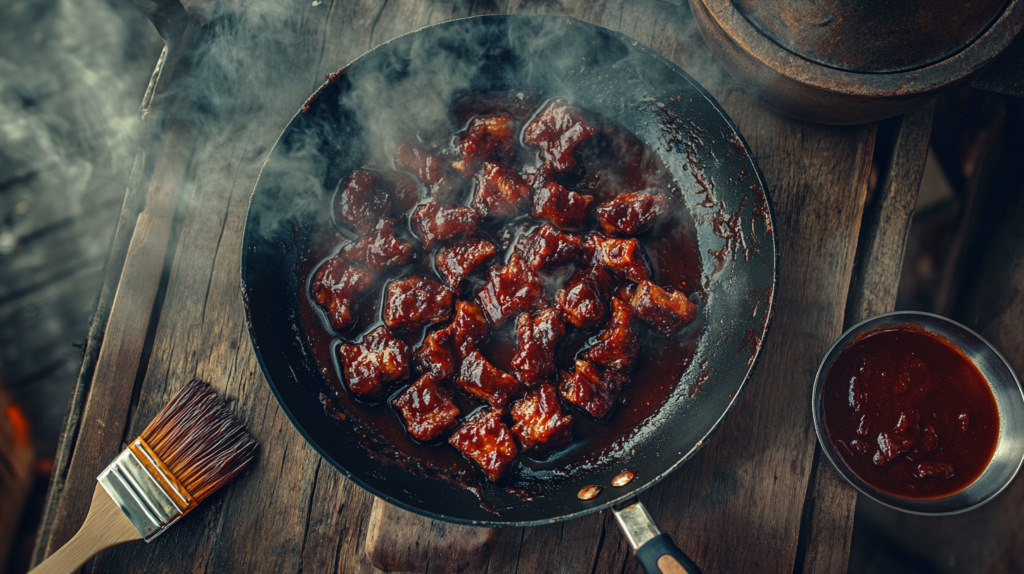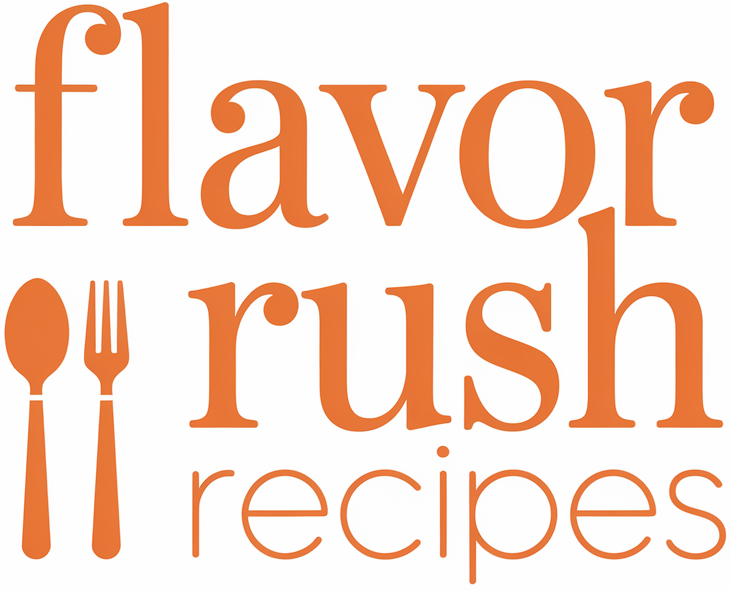If you’re looking to dive into the world of plant-based protein, seitan is a game-changer. This versatile meat substitute, made from vital wheat gluten, has been winning hearts (and taste buds) for centuries. Whether you’re a seasoned vegan or just curious about meat alternatives, this guide will walk you through everything you need to know about seitan recipes. For a simple and beginner-friendly recipe, check out this easy seitan recipe by Nora Cooks. From its rich history to step-by-step cooking methods and creative dishes, you’ll discover why seitan is a must-try for anyone exploring high-protein, vegan-friendly meals. Let’s get started!
Table of Contents
What is Seitan and Why You Should Try It
What is Seitan? A High-Protein Meat Alternative
Seitan, often called “wheat meat,” is a plant-based protein made from vital wheat gluten. Unlike tofu or tempeh, which are soy-based, seitan has a chewy, meat-like texture that makes it a favorite in vegan recipes. It’s packed with protein, making it a fantastic option for those looking to reduce meat consumption without sacrificing flavor or texture.
The History of Seitan: From Ancient Times to Modern Kitchens
Believe it or not, seitan isn’t a new trend. Its origins trace back to ancient China, where Buddhist monks created it as a meat substitute. Fast forward to today, and seitan has become a staple in vegan and vegetarian diets worldwide. Its ability to mimic the texture of meat has made it a go-to ingredient for everything from seitan steaks to vegan sausages.
Health Benefits of Seitan: Why It’s a Great Plant-Based Protein
Seitan isn’t just tasty it’s nutritious too! It’s low in fat and carbs but high in protein, making it a great choice for fitness enthusiasts or anyone looking to maintain a balanced diet. Plus, it’s rich in iron and selenium, which are essential for energy and immunity. However, since it’s made from wheat gluten, it’s not suitable for those with gluten intolerance.
Seitan vs. Other Meat Substitutes: Tofu, Tempeh, and Beyond
When it comes to meat alternatives, seitan stands out for its unique texture. Tofu is soft and crumbly, while tempeh has a nutty flavor and firmer bite. Seitan, on the other hand, is chewy and dense, making it perfect for dishes that require a meaty feel. Whether you’re grilling, frying, or simmering, seitan adapts beautifully to various cooking methods.
By now, you’re probably itching to try your hand at a seitan recipe. But before you do, let’s talk about the essential ingredients you’ll need to get started.
Essential Ingredients for Making Seitan
Vital Wheat Gluten: The Key Ingredient for Seitan Recipes
At the heart of every seitan recipe is vital wheat gluten, the protein-rich flour that gives seitan its meaty texture. This ingredient is what binds everything together, creating that chewy, satisfying bite. You can find it in most health food stores or online, and it’s a pantry staple for anyone diving into plant-based cooking.
Liquid Ingredients: Broths, Soy Sauce, and More for Flavor
While vital wheat gluten forms the base, liquid ingredients bring flavor and moisture to your seitan. Vegetable broth, soy sauce, or even coconut aminos can be used to infuse your seitan with savory, umami notes. Don’t shy away from experimenting with different liquids to find your favorite combination.
Seasonings and Spices: Customizing Your Seitan Recipe
Here’s where you can get creative! Garlic powder, onion powder, smoked paprika, and nutritional yeast are just a few options to elevate your seitan recipe. These seasonings not only add depth but also help mimic the flavors of traditional meat dishes.
Optional Add-Ins: Nutritional Yeast, Chickpea Flour, and More
For an extra boost of flavor and nutrition, consider adding nutritional yeast for a cheesy taste or chickpea flour for a softer texture. These add-ins can take your seitan from good to gourmet, making it a versatile ingredient for countless dishes.
Step-by-Step Guide to Making Basic Seitan

Preparing Your Workspace: Tools and Equipment You’ll Need
Before you start, gather your tools: a large mixing bowl, a whisk, and a clean surface for kneading. You’ll also need a pot for boiling or a steamer basket, depending on your preferred cooking method. Having everything ready will make the process smoother and more enjoyable.
Mixing the Dough: How to Achieve the Perfect Texture
In a large bowl, combine vital wheat gluten with your dry seasonings. Gradually add your liquid ingredients while stirring until a dough forms. At first, it might seem crumbly, but as you mix, it’ll come together into a firm, elastic ball.
Kneading and Shaping: Tips for Creating Meat-Like Consistency
Kneading is where the magic happens! Spend about 5-10 minutes working the dough to develop its gluten structure. This step ensures your seitan has that chewy, meat-like texture. Once kneaded, shape it into logs, cutlets, or even small chunks, depending on your recipe.
Cooking Methods: Boiling, Steaming, Baking, or Simmering Seitan
Now comes the fun part of cooking! Boiling is the most common method; simply simmer your seitan in flavorful broth for about 45 minutes. Alternatively, you can steam it for a firmer texture or bake it for a crispy exterior. Each method offers a unique twist, so feel free to experiment.
Storing and Freezing Seitan for Future Use
Once cooked, let your seitan cool before storing it. It’ll keep in the fridge for up to a week or in the freezer for several months. This makes it a convenient make-ahead protein for busy weeknights or meal prep.
5 Creative Seitan Recipes to Try at Home

Classic Seitan Steaks: A Simple and Versatile Recipe
If you’re new to seitan recipes, start with this classic. Mix vital wheat gluten with garlic powder, onion powder, and soy sauce, then knead and simmer in vegetable broth. Once cooked, slice it into steaks and pan-fry for a crispy exterior. Serve with mashed potatoes and gravy for a hearty, plant-based meal that’ll impress even meat lovers.
Seitan BBQ Ribs: Smoky and Savory Plant-Based Delight
Craving something smoky? These seitan BBQ ribs are a crowd-pleaser. Shape your seitan dough into rib-like strips, then bake or grill until firm. Slather with your favorite BBQ sauce and broil for a sticky, caramelized finish. Pair with coleslaw and cornbread for the ultimate comfort food experience.
Seitan Fried Chicken: Crispy and Juicy Vegan Comfort Food
Yes, you can enjoy fried chicken without the meat! For this seitan recipe, shape the dough into nuggets or cutlets, then coat in a seasoned flour mixture and breadcrumbs. Fry until golden and crispy, or bake for a healthier twist. Dip in vegan ranch or hot sauce for a finger-licking treat.
Seitan Stir-Fry: Quick and Easy Weeknight Dinner Idea
Short on time? This stir-fry is your answer. Slice cooked seitan into thin strips and toss it into a hot wok with your favorite veggies think bell peppers, broccoli, and snap peas. Add a splash of soy sauce, garlic, and ginger for a flavorful, high-protein meal that’s ready in under 30 minutes.
Seitan Sausages: Perfect for Breakfast or Grilling
Homemade seitan sausages are easier than you think! Mix your dough with fennel seeds, smoked paprika, and a touch of maple syrup for that classic sausage flavor. Shape into links, then steam or boil until firm. Grill or pan-fry for a smoky finish, and serve with mustard and sauerkraut for a vegan-friendly twist on a classic.
Tips and Tricks for Perfecting Your Seitan Recipe
How to Avoid Common Seitan Mistakes
Even seasoned cooks can run into issues with seitan. One common mistake is over-kneading, which can make the texture too dense. On the flip side, under-kneading can result in a crumbly mess. Aim for a smooth, elastic dough, and don’t rush the process.
Adjusting Texture: Chewy, Tender, or Firm Seitan
The beauty of seitan lies in its versatility. For a chewier texture, knead longer and boil for less time. If you prefer it tender, add a bit of chickpea flour to the dough and steam instead of boiling. Experiment to find your perfect balance.
Enhancing Flavor: Marinating and Seasoning Techniques
Seitan is like a blank canvas—it soaks up flavors beautifully. After cooking, marinate it in a mix of soy sauce, garlic, and herbs for at least an hour. Alternatively, add spices like cumin, coriander, or chili powder directly to the dough for a flavor boost.
Pairing Seitan with Sauces, Sides, and Toppings
The right accompaniments can take your seitan recipe to the next level. Think tangy BBQ sauce, creamy vegan gravy, or zesty chimichurri. For sides, roasted veggies, quinoa, or a fresh salad work wonders. Don’t forget toppings like pickled onions or avocado for added flair.
Conclusion
Seitan is a game-changer for anyone exploring plant-based cooking or looking to add more high-protein meals to their diet. With its meaty texture and versatility, it’s no wonder this ancient ingredient has become a modern kitchen staple. Whether you’re whipping up seitan steaks, smoky BBQ ribs, or crispy fried chicken, the possibilities are endless. Plus, with tips on perfecting texture, enhancing flavor, and storing leftovers, you’ll be a seitan pro in no time. For more recipe inspiration, check out our Ultimate Chicken Salad Recipe. So, roll up your sleeves, grab that vital wheat gluten, and start creating delicious seitan recipes that’ll impress even the pickiest eaters. Happy cooking!
FAQs About Seitan Recipes
What Does Seitan Taste Like?
Seitan has a mild, savory flavor that easily absorbs the seasonings and liquids you cook it with. Its texture is chewy and meat-like, making it a great substitute in dishes like stir-fries, stews, and sandwiches. Think of it as a blank canvas for your favorite flavors!
Is Seitan Gluten-Free?
Unfortunately, no. Since seitan is made from vital wheat gluten, it’s not suitable for those with celiac disease or gluten intolerance. However, if you’re looking for a gluten-free alternative, consider tofu, tempeh, or legumes.
How Long Does Homemade Seitan Last?
Cooked seitan can be stored in the fridge for up to a week or frozen for several months. To freeze, wrap it tightly in plastic or place it in an airtight container. When you’re ready to use it, simply thaw and reheat.
Can I Make Seitan Without Vital Wheat Gluten?
While vital wheat gluten is the key ingredient in traditional seitan recipes, you can experiment with alternatives like chickpea flour or a mix of legumes and grains. Keep in mind, though, that the texture and protein content will differ significantly.
How Do You Make Seitan from Scratch?
Making seitan from scratch is simpler than you might think! Combine vital wheat gluten with seasonings and liquid, knead the dough, and cook it using your preferred method of boiling, steaming, or baking.
What Can I Use Instead of Vital Wheat Gluten for Seitan?
If you’re avoiding gluten, try using chickpea flour or a blend of legumes and grains. While the texture won’t be the same, these alternatives can still create a tasty, protein-rich dish.
Is Seitan Healthier Than Tofu?
Both seitan and tofu have their perks. Seitan is higher in protein but contains gluten, while tofu is gluten-free and rich in calcium. The choice depends on your dietary needs and preferences.
Can I Freeze Cooked Seitan?
Absolutely! Cooked seitan freezes well and can be stored for months. Just make sure to wrap it tightly or use an airtight container to prevent freezer burn.


1 thought on “The Ultimate Guide to Making Delicious Seitan Recipes at Home”
Comments are closed.